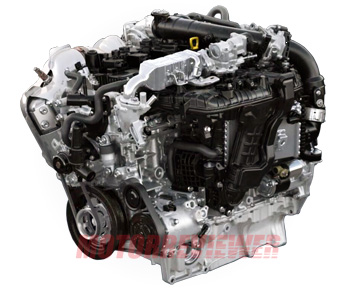Mazda 3.3 Turbo Skyactiv-G Engine Specs, Problems, Reliability, Info

Mazda 3.3L Skyactiv-G Engine Info
The Skyactiv-G 3.3, also known as H3T or H3-VPTS, is a 3.3-liter inline six-cylinder gasoline engine with direct fuel injection and twin-scroll turbocharging. It is a new engine from the SkyActiv family, which was first introduced in 2023 along with the newly developed full-size crossover SUV Mazda CX-90. This engine is available with two output versions, 280 hp and 332 lb-ft (450 Nm) or 340 hp and 369 lb-ft (500 Nm)), and it also goes with a 48-volt mild-hybrid-assist system (MHEV) that can add 17 hp and 113 lb-ft of torque. Let's dive into the design of the 3.3 Turbo Skyactiv-G engine, its features, problems, and reliability.
Skyactiv-G 3.3 Design and Features
The Skyactiv-G 3.3T H3T engine wasn't built from scratch. Mazda relied on the experience gained in the production of the Skyactiv-G 2.5T. Also, there are some similarities between this gasoline engine and the 3.3-liter SkyActiv-D diesel, debuted a year earlier. The new 3.3-liter Mazda’s turbo inline-six is an all-aluminum engine. It has a light-weight aluminum open-deck style cylinder block and an aluminum DOHC head with 4 valves per cylinder. While the current 4-cylinder 2.5T engine has dish-top pistons, the 3.3T inline-six model is equipped with dome shaped pistons. The compression ratio has increased from 10.5 to 12.0. The H3T now utilizes electronically controlled piston oil jets/squirters. Their operation depends on engine loads.
The 3.3T cylinder head also features an integrated exhaust manifold, but instead of three port for the Mazda’s Dynamic Pressure Turbo system, there are two exhaust ports for a single twin-scroll Garrett turbocharger. The shape of the intake ports on this engine is slightly different from that of the 2.5L turbo engine has. The shape was optimized for better air flow. On top of the head, there are two (intake and exhaust) chain-driven camshafts. Both of them come with sequential variable valve timing (Dual S-VT). Valves are actuated via rocker arms equipped with hydraulic lash adjusters.
Fueling is a Gasoline Direct Injection (GDI) system: fuel is injected directly into the combustion chambers through direct injectors. These injectors shoot fuel from the side at a small angle, while the spark plugs are located at the top center of the combustion chamber. Compressed air first passes through an air-to-water intercooler, which is mounted underneath the plastic intake manifold. The 3.3T SkyActiv-G engine also has a water-cooled exhaust gas recirculation (EGR) system.
Two Versions: 280 hp vs 340 hp
Mazda offers the 3.3L SkyActiv-G engine in two power output variants. The base models come with an engine that produces 280 horsepower and 332 pound-feet of torque, while the top-of-the-line models get a more powerful 340 hp/369 lb-ft engine. Mechanically, they are identical, with the only difference being the boost pressure. The low-power version has 14 pounds of boost, and it runs on regular fuel. The higher-output six has about 19 pounds of boost, and it requires a premium fuel (you can use regular gas, but the max horsepower will drop to 319).
Engine Specs
Oil recommendations and capacity may vary depending on the car model, year, and market. Please check the service manual specific to your vehicle!
The Most Common Problems
The engine was recently introduced and, for now, there have been no major issues reported. If breakdowns do occur, then most of the time, they are easy to fix. The only thing is that a number of mechanics note difficulties with engine maintenance. It is quite complicated and crammed engine.
However, there are some concerns that are worth mentioning. The first issue is carbon build-up. This is a downside of using direct fuel injection. There is no fuel in the intake ports, which helps to wash away sludge and oil from the valves and other surfaces. Over time, the engine can accumulate carbon inside the intake ports, which can lead to a significant air flow restrictions (power drops, engine consumes more fuel, etc.). Also, the GDI engines are very sensitive to fuel quality. Poor quality gasoline can easily destroy a high-pressure fuel pump or clog direct fuel injectors. Oiling and cooling are another crucial points, because turbocharged engines are usually operating hotter. Use only recommended oil, change it frequently, and keep cooling radiator clean.
Skyactiv-G 3.3 Turbo Reliability and Longevity
There is no real data yet. But, an approximate longevity of the Mazda 3.3-liter turbo Skyactiv-G engine is about 200,000 miles (300,000 km). However, the actual numbers depend on various factors, such as operating conditions, fuel and motor oil quality, maintenance, and so on. In this case, the real lifespan could be either less or more.
